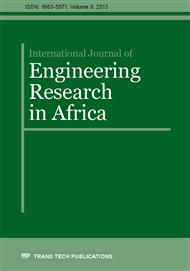[1]
E.U. Odigboh, Cassava: Production, Processing and Utilization, in T. Chan Jr. (ed.) Int. Handbook of Tropical Foods, Marcel Dekker Inc., New York, 1983, pp.145-200.
Google Scholar
[2]
FAO, Cassava Market Assessment, FAO Agricultural Services Bulletin, 2003, No.8.
Google Scholar
[3]
J.H. Cock, Cassava: New Potential for a Neglected Crop, Westview Press, Boulder, Colorado, 1985.
Google Scholar
[4]
A. Kronchmal, A Propagation of Cassava, World Crops, 21 (1969) 193-195.
Google Scholar
[5]
A.B. Sukra, T. Ahmad and S.L. Tan, Modified API Cassava Stem Planter: performance, owning and operating costs, MARDI Report No. 144, MARDI Serdang, Malaysia, 2003.
Google Scholar
[6]
K.M. Olsen, and B.A. Schaal, Evidence on the Origin of Cassava: Phylogeography of Manihot Esculenta, Proceedings of the National Academy of Sciences of the United States of America (PNAS), 96(10) (1999) : 5587-5590.
DOI: 10.1073/pnas.96.10.5586
Google Scholar
[7]
J.P. Holdren, G. Morris and I. Mintzer, Environmental Aspects of Renewable Energy Sources in J. M. Hollander (Ed.), Annual Review of Energy; Annual Review Inc. California, Vol.5 , 1980 pp.313-451.
DOI: 10.1146/annurev.eg.05.110180.001325
Google Scholar
[8]
D. Pimental, Ethanol Fuels: Energy Security, Economics and the Environment, J. Agric. & Environ. Ethics, 4 (1991) 1-13.
Google Scholar
[9]
J.C. Kim and D. De Reuter, Bakery Products with non-wheat flours, Baker's Digest, 43(3) (1968) 58-63.
Google Scholar
[10]
M.J. Taherzadeh and K. Karimi, Enzymatic based hydrolysis processes for ethanol from lignocellulosic materials: A Review, Bio-Resources 2(4) (2007) 707-738.
Google Scholar
[11]
O. Jones, US2000 Improvement in the manufacture of Starch, Class: 127/68 48/119 and 127/69, Middlesex, England, USPTO 2008.
Google Scholar
[12]
UNCTAD/GATT, The markets for manioc (cassava tuber) as a raw material for the manufacture of compound animal feeding-stuffs in the Federal Republic of Germany, Netherlands and Belgium, The International Trade Centre, Geneva. Report No. 2 1968.
Google Scholar
[13]
S.L. Tan, A.B. Sukra and K.I. Tan, Viability of commercial cassava production for animal feed, Proc. Intern. Conf. on "Advances in Animal Feeds and Feeding in the Tropics, held in Gentling Highlands Pahang, Serdang, Malaysian Soc. Animal Production (1987) 14-33.
Google Scholar
[14]
O. Padmaja, Cyanide detoxification in cassava for food and feed uses, Crit. Rev. Food Sci. Nutr.(1995) 229-239.
Google Scholar
[15]
J.H. Bradbury, Simple wetting method to reduce cyanogen content of cassava flour, Journal of food composition and analysis, Elsevier, NY, 19(4) (2006): 388-393.
DOI: 10.1016/j.jfca.2005.04.012
Google Scholar
[16]
E.N. Ohwovoriole, S. Oboli and A.C. Mgbeke, Studies and Preliminary Design for a Cassava Tuber Peeling Machine", Journal of Power and Machinery of ASAE (1991) 12-20.
DOI: 10.13031/2013.30718
Google Scholar
[17]
G.O. Ezekwe, Mechanizing Cassava Peeling: The PRODA Cassava Nibbling Machine, PRODA Technical Reports, No.1, (1979), 1-20.
Google Scholar
[18]
P.M. Nwokedi, Performance of a Cassava Peeling Machine, in E. R. Terry, E. U. Doku, O. B. Arene and M. Mahungu (Eds.), Int. Tropical Root Crops: Production and Uses in Africa, International Research Centre, 1984, pp.108-110.
Google Scholar
[19]
G.O. Ariavie, Development of an Improved Ohwovoriole Cassava Peeling Machine", M.Eng Thesis, Department of Mechanical Engineering, University of Benin, Benin City, Nigeria, 1999.
Google Scholar
[20]
E.U. Odigboh, A Cassava Peeling Machine: Development, Design and Construction, J. Agric. Engineering Res. 21(3) (1976) 361-469.
DOI: 10.1016/0021-8634(76)90056-1
Google Scholar
[21]
N.N. Mohesenin, Physical Properties of Plant and Animal Materials, Gordon and Breach Science Publishers NY, Vol.1 ,1970.
Google Scholar
[22]
P.O. Ebunilo and W.O. Emofurieta, A Study and Evaluation of a Manually Operated Cassava Tuber Sizing, Cutting and Sorting Machine, Tropical Journal of Environmental Science & Health, 10(1) (2007) 37-42.
Google Scholar
[23]
R.L. Norton, Design of Machinery: An Introduction to the Synthesis and Analysis of Mechanisms and Machines, McGraw-Hill Publishers, second ed., 1999.
Google Scholar


